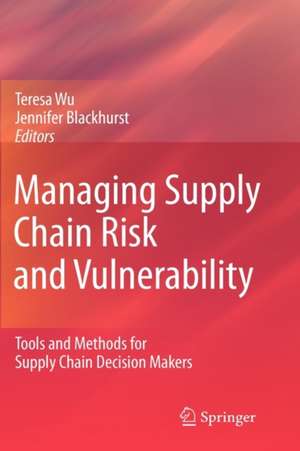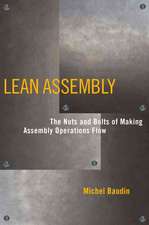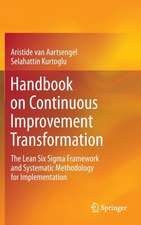Managing Supply Chain Risk and Vulnerability: Tools and Methods for Supply Chain Decision Makers
Editat de Teresa Wu, Jennifer Vincent Blackhursten Limba Engleză Hardback – 28 aug 2009
Leading academic researchers, as well as practitioners, have contributed chapters focusing on developing an overall understanding of risk and its relationship to supply chain performance; investigating the relationship between response time and disruption impact; assessing and prioritizing risks; and assessing supply chain resilience.
Supply chain managers will find Managing Supply Chain Risk and Vulnerability a useful tool box for methods they can employ to better mitigate and manage supply chain risk. On the academic side, the book can be used to teach senior undergraduate students, as well as graduate-level students. Additionally, researchers may use the text as a reference in the area of supply chain risk and vulnerability.
| Toate formatele și edițiile | Preț | Express |
|---|---|---|
| Paperback (1) | 942.13 lei 6-8 săpt. | |
| SPRINGER LONDON – 18 sep 2014 | 942.13 lei 6-8 săpt. | |
| Hardback (1) | 948.16 lei 6-8 săpt. | |
| SPRINGER LONDON – 28 aug 2009 | 948.16 lei 6-8 săpt. |
Preț: 948.16 lei
Preț vechi: 1156.29 lei
-18% Nou
Puncte Express: 1422
Preț estimativ în valută:
181.44€ • 194.01$ • 151.27£
181.44€ • 194.01$ • 151.27£
Carte tipărită la comandă
Livrare economică 17 aprilie-01 mai
Preluare comenzi: 021 569.72.76
Specificații
ISBN-13: 9781848826335
ISBN-10: 1848826338
Pagini: 246
Ilustrații: XI, 232 p.
Dimensiuni: 155 x 235 x 25 mm
Greutate: 0.52 kg
Ediția:2009
Editura: SPRINGER LONDON
Colecția Springer
Locul publicării:London, United Kingdom
ISBN-10: 1848826338
Pagini: 246
Ilustrații: XI, 232 p.
Dimensiuni: 155 x 235 x 25 mm
Greutate: 0.52 kg
Ediția:2009
Editura: SPRINGER LONDON
Colecția Springer
Locul publicării:London, United Kingdom
Public țintă
Professional/practitionerDescriere
Effective supply chain management is a critical component of any company’s ability to meet consumer demand. Disruptions to the supply chain disturb the normal flow of goods and materials and, as a consequence, expose firms to operational and financial risks. Managing Supply Chain Risk and Vulnerability, a book that both practitioners and students can use to better understand and manage supply chain risk, presents topics on decision making related to supply chain risk.
Because a supply chain disruption can be potentially so harmful and costly, there has been a recent surge in interest – from academics and practitioners alike – in supply chain disruptions and related issues. Leading academic researchers, as well as practitioners, have contributed chapters focusing on developing an overall understanding of risk and its relationship to supply chain performance; investigating the relationship between response time and disruption impact; assessing and prioritizing risks; and assessing supply chain resilience, as well as providing tools and methods for assisting with decision making and risk mitigation in the supply chain.
Supply chain managers will find Managing Supply Chain Risk and Vulnerability a useful tool box for methods they can employ to better mitigate and manage supply chain risk. On the academic side, the book can be used to teach senior undergraduate engineering, supply chain, and operations students focusing on current supply chain topics, as well as graduate-level engineering and MBA students. Additionally, researchers may use the text as a reference in the area of supply chain risk and vulnerability.
Because a supply chain disruption can be potentially so harmful and costly, there has been a recent surge in interest – from academics and practitioners alike – in supply chain disruptions and related issues. Leading academic researchers, as well as practitioners, have contributed chapters focusing on developing an overall understanding of risk and its relationship to supply chain performance; investigating the relationship between response time and disruption impact; assessing and prioritizing risks; and assessing supply chain resilience, as well as providing tools and methods for assisting with decision making and risk mitigation in the supply chain.
Supply chain managers will find Managing Supply Chain Risk and Vulnerability a useful tool box for methods they can employ to better mitigate and manage supply chain risk. On the academic side, the book can be used to teach senior undergraduate engineering, supply chain, and operations students focusing on current supply chain topics, as well as graduate-level engineering and MBA students. Additionally, researchers may use the text as a reference in the area of supply chain risk and vulnerability.
Cuprins
1. Effective Management of Supply Chains: Risks and Performance 2. Managing Supply Chain Disruptions via Time-Based Risk Management 3. Prioritization of Risks in Supply Chains of Small and Medium Enterprises (SMEs) Clusters Using Fuzzy-AHP Approach 4. A Generalized Simulation Framework for Responsive Supply Network Management 5. Modeling of Supply Chain Risk under Disruptions with Performance Measurement and Robustness Analysis 6. The Effects of Network Relationships on Global Supply Chain Vulnerability 7. A Stochastic Model for Supply Chain Risk Management Using Conditional Value at Risk 8. Risk Intermediation in Supply Chains 9. Forecasting and Risk Analysis in Supply Chain Management: GARCH Proof of Concept 10. Supply Chain Risk Management: Annotation of Knowledge Using A Semi-Structured Knowledge Model
Notă biografică
Teresa Wu is an associate professor at Arizona State University, USA. Her research interests are Supply Chain Management (Supplier Evaluation); Collaborative Product Development; Distributed Decision Making; and Distributed Information System Development. She has industrial experience from three years spent with the Beijing Aviation Simulator Co. as a software engineer and system administrator. Teresa Wu was given the Nationa Science Foundation CAREER award (2003-2008).
Jennifer Blackhurst, Ph.D. is an Associate Professor of Logistics and Supply Chain Management in the College of Business at Iowa State University. She received her doctorate in Industrial Engineering from the University of Iowa in 2002. Her research interests include: Supply Chain Risk and Disruption; Supply Chain Coordination; and Supplier Assessment and Selection. Her publications have appeared or been accepted in such journals as Journal of Operations Management, Production and Operations Management, International Journal of Production Research, and IEEE Transactions on Engineering Management. She is a member of POMS and DSI.
Jennifer Blackhurst, Ph.D. is an Associate Professor of Logistics and Supply Chain Management in the College of Business at Iowa State University. She received her doctorate in Industrial Engineering from the University of Iowa in 2002. Her research interests include: Supply Chain Risk and Disruption; Supply Chain Coordination; and Supplier Assessment and Selection. Her publications have appeared or been accepted in such journals as Journal of Operations Management, Production and Operations Management, International Journal of Production Research, and IEEE Transactions on Engineering Management. She is a member of POMS and DSI.
Textul de pe ultima copertă
Effective supply chain management is a critical component of any company’s ability to meet consumer demand. Disruptions to the supply chain disturb the normal flow of goods and materials and, as a consequence, expose firms to operational and financial risks. Managing Supply Chain Risk and Vulnerability, a book that both practitioners and students can use to better understand and manage supply chain risk, presents topics on decision making related to supply chain risk.
Because a supply chain disruption can be potentially so harmful and costly, there has been a recent surge in interest – from academics and practitioners alike – in supply chain disruptions and related issues. Leading academic researchers, as well as practitioners, have contributed chapters focusing on developing an overall understanding of risk and its relationship to supply chain performance; investigating the relationship between response time and disruption impact; assessing and prioritizing risks; and assessing supply chain resilience, as well as providing tools and methods for assisting with decision making and risk mitigation in the supply chain.
Supply chain managers will find Managing Supply Chain Risk and Vulnerability a useful tool box for methods they can employ to better mitigate and manage supply chain risk. On the academic side, the book can be used to teach senior undergraduate engineering, supply chain, and operations students focusing on current supply chain topics, as well as graduate-level engineering and MBA students. Additionally, researchers may use the text as a reference in the area of supply chain risk and vulnerability.
Because a supply chain disruption can be potentially so harmful and costly, there has been a recent surge in interest – from academics and practitioners alike – in supply chain disruptions and related issues. Leading academic researchers, as well as practitioners, have contributed chapters focusing on developing an overall understanding of risk and its relationship to supply chain performance; investigating the relationship between response time and disruption impact; assessing and prioritizing risks; and assessing supply chain resilience, as well as providing tools and methods for assisting with decision making and risk mitigation in the supply chain.
Supply chain managers will find Managing Supply Chain Risk and Vulnerability a useful tool box for methods they can employ to better mitigate and manage supply chain risk. On the academic side, the book can be used to teach senior undergraduate engineering, supply chain, and operations students focusing on current supply chain topics, as well as graduate-level engineering and MBA students. Additionally, researchers may use the text as a reference in the area of supply chain risk and vulnerability.
Caracteristici
Presents topics on the assessment, modelling and monitoring of supply chain risk
Includes supplementary material: sn.pub/extras
Includes supplementary material: sn.pub/extras
















